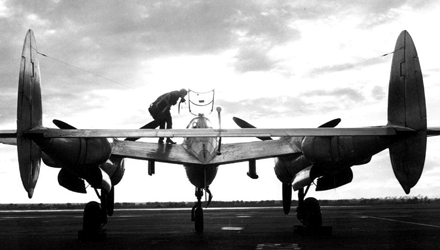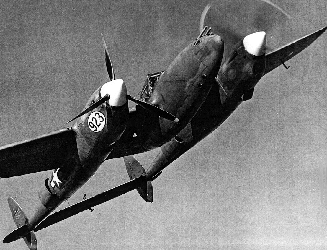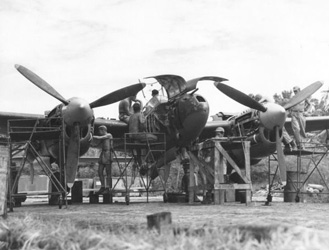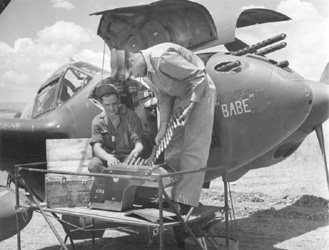P-38 Lightning
Lightning in Action
Les premiers Lightning utilisés en opération, furent des F-4 (version de reconnaissance du P-38E) en 1942 au sein de la Royal Australian Air Force. Toujours en 1942, c'est dans l'archipel des Aléoutiennes (Alaska) que la version de chasse connaîtra son baptême du feu. Notons que la plupart des appareils perdus, furent perdus en raison de la rudesse du climat plus que par l'action des Japonais. Le Lightning participa ensuite aux campagnes d'Afrique en 1942-1943 et d'Italie à partir de 1943. En Europe (ETO), les P-38 servent au sein de la 8th USAAF et de la 9th USAAF. En Méditerranée (MTO), ils servent au sein de la 15th USAAF.
The first Lightning used in operation, were F-4 (P-38E reconnaissance version) in 1942 in the Royal Australian Air Force. In 1942, this is in the archipelago of the Aleutians (Alaska) that the fighter version will have its baptism of fire. Note that most of the lost aircraft, were lost due to the harshness of the climate than by the action of the Japanese. The Lightning then participated in campaigns in Africa in 1942-1943 and Italy from 1943. In Europe (ETO), the P-38 are used within the USAAF 8th and 9th USAAF. In the Mediterranean (MTO), they serve within the 15th USAAF.
 |
 |
Les 3 principaux chasseurs américains
en Europe, le Ligntning, le Mustang et au dessus, le Thunderbolt.
Les trois possédaient un très long rayon d'action.
|
Formation de P-38 en plein vol. Les Allemands
le surnomment Gabelschwanz Teufel, signifiant « diable à
queue fourchue ». |
3 Major American fighters
in Europe, the Ligntning, Mustang and above, the Thunderbolt. The
three had a very long range. |
P-38 unit in flight.
The Germans nicknamed it "Gabelschwanz Teufel", meaning
'forked-tailed devil '. |
src: WWII
Vehicles |
src: WWII
Vehicles |
Bien qu'étant un avion robuste et confortable avec un cockpit vaste et facile d’accès, le P-38 lors de son entrée en service fut jugé plus difficile à piloter qu'un chasseur monomoteur classique. Cette constatations est due en partie au manque d'entraînement des pilotes et des maladies de jeunesse du P-38, qui à cette époque connaissait des problèmes à haute altitude (jusqu'au P-38H) en raison d'un système de refroidissement inadapté. Cependant avec les nouveaux modèles P-38J et P-38L, ces problème seront résolus et le P-38 connu le succès à toutes les altitudes au dessus de l'Italie et de l'Allemagne. Cependant avant le P-38J-25, les pilotes de P-38 se faisaient facilement avoir par les pilote allemands à cause de l'absence de volets de plongée pouvant contrer la compressibilité en piqué. Les chasseurs allemands pouvant donc s'échapper relativement facilement en piqué car les pilotes des Lightning n'aimaient pas les suivre. Le Général de la Lutwaffe, Galland, guère impressionné, estima que les chasseurs allemands Bf.109 et FW.190 était largement supérieur au Lightning
Although that is a robust and comfortable aircraft with a wide and easy access cockpit, the P-38 during its entry into service was considered more difficult to fly than a classic single-engine fighter. This findings is due in part to the lack of training of pilots and diseases of youth of the P-38, who at the time knew of problems at high altitude (up to the P-38H) due to inadequate cooling system. However with the new P-38J and P-38L models, the problem will be solved and the P-38 knewn the success at all altitudes over the Italy and the Germany. However before the P-38J-25, P-38 pilots were easily avoided by the German pilots because of the absence of dive flaps that can counter compressibility in dive. German fighters can therefore escape relatively easily in spades because the Lightning pilots did not follow them. The General of the Luftwaffe, Galland, hardly impressed, estimated that German Bf.109 and FW.190 fighters was far superior to the Lightning.
 |
 |
Pilotes d'une escadrille recevant leurdernières
instructions de mission. |
Démontage d'une caméra sur un
Lightning de reconnaissance. |
Drivers of a squadron
receiving their last mission statements. |
Recovery of a camera on
a Lightning of reconnaissance. |
src: WWII
Vehicles |
src: WWII
Vehicles |
Cependant dès le début la configuration en bimoteur offrait un sérieux gage de sécurité aux pilotes et permettait souvent à un pilote de retourner à sa base avec un moteur en panne. Le P-38 fut surtout utilisé, sans véritable tactique établie, durant la période précédent la suprématie alliée sur le ciel européen et face à une Lutwaffe encore très déterminée et habile. Il fut un relativement bon prédécesseur avant l'engagement en masse du P-51 Mustang ou du P-47 Thunderbolt sur ce théâtre en étant le seul à pouvoir escorter les bombardiers sur de longues distances. Les plus grandes qualités du P-38 était en effet une très grande autonomie, mais aussi une forte capacité de charge, des montées rapides et un puissant armement dont le disposition concentrée permettait une très grande portée de tir. Ce dernier point faisait du Lightning un véritable Sniper des airs. Le P-38 fut aussi utilisé sur ce théâtre comme chasseur-bombardier, notamment en Normandie. Il effectua des raids contre les radars ennemis, les colonnes de blindés et autres objectifs au sol. Cependant en 1944-1945, dès qu'il sera possible, le Lightning sera remplacé par le Mustang, le P-38 étant au fil du temps de plus en plus cantonné à un rôle de reconnaissance.
However since the begining, the twin-engine configuration offered a serious guarantee of safety to the pilots and often allow a pilot to return to its base with a failed engine. The P-38 was used primarily, without real tactics established, during the previous Allies' supremacy period on the European sky and facing to a Luftwaffe yet very determined and skilful. It was a relatively good predecessor before the mass supplies of the P- 51 Mustang and P-47 Thunderbolt on this theatre being the only one able to escort the bombers over long distances. The qualities of the P-38 was indeed a very large autonomy, but also a high load capacity, rapid climbs and a powerful armament of the concentrated provision allowed a very large fire range. This last point made of the Lightning a real air Sniper. The P-38 was also used in the theatre as a fighter-bomber, especially in Normandy. It conducted raids against enemy radar, armor columns and other targets on the ground. However in 1944-1945, as soon as it is possible, the Lightning will be replaced by Mustang, P-38, during the course of time more and more stationed in a reconnaissance role.
 |
 |
Belle vue d'un Lightning au couché de
soleil. |
Piloter un bimoteur était un avantage
apréciable en cas de panne d'un moteur. |
Beautiful view of a Lightning
at Sunset. |
Fly a twin-engine aircraft
was a significant benefit if engine failure . |
src: WWII
Vehicles |
src: WWII
Vehicles |
Sur le théâtre du Pacifique, les pilotes de Lightning détruisirent 1800 avions japonais (plus que tout autre chasseur sur ce secteur d'opération), et plus de cent d'entre-eux devinrent des as (plus de 5 avions abattus). Si le Lightning ne pouvait rivaliser en combat tournoyant avec le Zero et les autres chasseurs japonais, se grande vitesse et son bon taux de montée, lui permettait d'effectuer de nombreux passages rapides sur sa cible pour la mitrailler. La puissance de feu et la grande portée de tir de son armement firent des ravages sur la faible protection chronique des chasseurs japonais (les chasseurs allemands étant bien plus solides et coriaces à ce point de vue). La grande autonomie du Lightning (améliorée par un mélange allégé) couplé aux capacités élevées de ravitaillement et de maintenance de l'US Navy, firent merveille sur ce théâtre aux distances gigantesques au dessus de l'océan. A la fin 1944, il n'était pas rare que les P-38L en Nouvelle Guinée néerlandaise effectuent des déplacements de 1530 km, combattent durant 15 minutes et retournent à leur base. Cependant, le théâtre du Pacifique resta relativement peu fourni en comparaison du théâtre européen, mais les Lightning y firent cependant du très bon boulot. Ce fut un Lightning qui abattit l'avion de l’amiral Yamamoto en 1943. Notons qu'en raison de la chaleur sous ces latitudes, les pilotes volaient souvent verrière ouvertes, ce qui pouvaient créer de fortes turbulences sur le stabilisateur arrière.
On the Pacific Theater, Lightning pilots destroyed 1800 Japanese aircraft (more than other fighter in this operation sector)and more one hundred of between them became Aces (more than 5 aircraft destroyed). If the Lightning could not compete in dogfight with Zero and other Japanese fighters, is high speed and its good rate of climb, allowed it to strafe many fast passages on its target. The firepower and the long fire range of its guns made havoc on the low chronic protection of Japanese fighters (the German fighters being far more solid and tough to this point of view). The autonomy of the Lightning (enhanced by a Lite mix) coupled with high supply and maintenance capacity of the U.S. Navy, made wonder in the theatre at huge distances across the ocean. At the end of 1944, it was not uncommon that the P-38 L in Dutch New Guinea perform raids of 1530 km, fight during 15 minutes, and return to their base. The Pacific Theater remained relatively providedin P-38 compared to the European Theater, the Lightning made however, very good job. This was a Lightning which destroyed the plane Admiral Yamamoto in 1943. Note that due to the heat in these latitudes, pilots flew often canopy open, which could create severe turbulence on the rear stabilizer.
 |
 |
Mécaniciens du 459th Fighter Squadon
(Dragon Sq), travaillant sur un P-38 sur la base de Chittagone en
Inde, en janvier 1945. |
Le Pilote et un armurier inspectent les prohectiles
du canon de 20 mm. |
Mechanics of the 459th
Fighter Squadon (Dragon Sq) , working on a P-38 at the Chittagone
base in India, in January 1945. |
Pilot and aircraft armorer
inspect ammo of the 20 mm gun |
src: Wikipedia |
src: WWII
Fighters |
Notons que si le Lightning n'était pas le meilleur chasseur américain de la seconde guerre mondiale, il compte en son rang les deux plus grands as de l'USAAF de ce conflit; Richard I. Bong (plus grand as américain de l'histoire avec 40 victoires) et Thomas McGuire (38 victoires), les deux opérant dans le Pacifique. L'un des pilote de Lightning les lus célèbres, fut le pilote-écrivain français Antoine de Saint-Exupéry (auteur du Petit Prince), qui disparaît au cours d'une mission Ajaccio-Chambéry, avec son F-5B-1-LO de reconnaissance, le 31 juillet 1944.
Note that if the Lightning was not the best American fighter of World War II, it has in its ranks the two bigger aces the USAAF in this conflict; Richard I. Bong (the great American ace in history with 40 victories) and Thomas McGuire (38 victories), both operating in the Pacific. One of Lightning more famous pilot, was theFrench pilot-writer Antoine de Saint-Exupéry (author of The Little Prince), who disappears during a mission Ajaccio-Chambery, with its F- 5B-1-LO of reconnaissance, on July 31, 1944.
Sources: